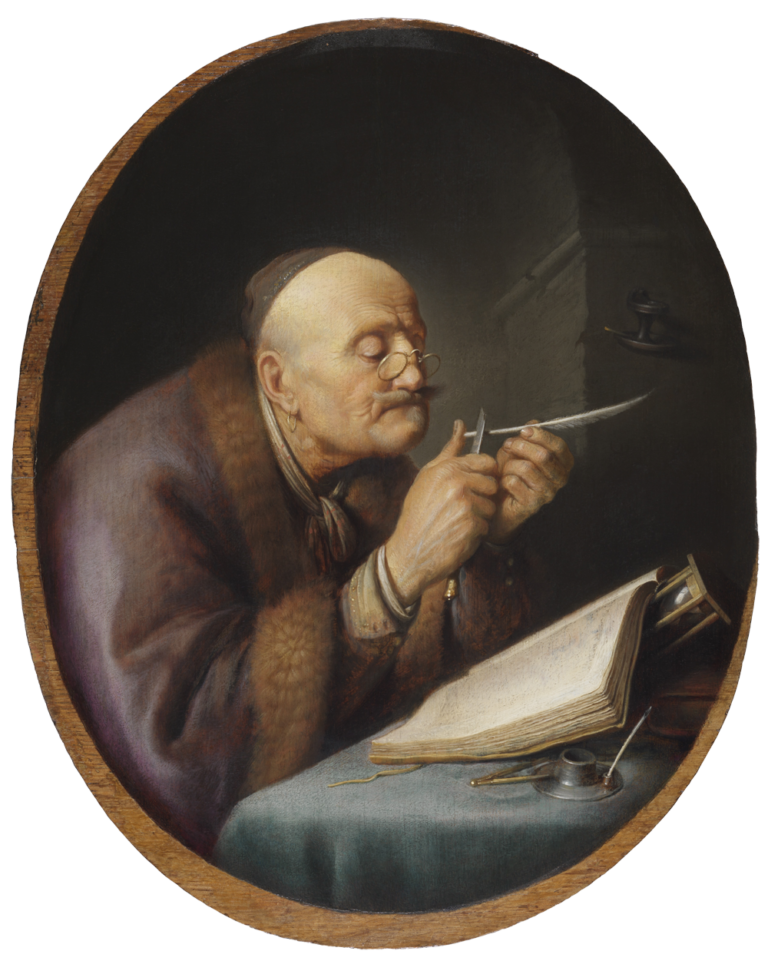An elderly scholar, clad in a purplish-brown skullcap and fur-trimmed tabard, is seated at his study before an open book. With clenched chin and furrowed brow, he cautiously attempts to slice the tip of a quill pen, using the soft pad of his thumb to balance the tip against the pressure of his blade. Concentrating on the precision of his task, he peers intently at the quill through gold-trimmed spectacles perched at the end of his nose.
The theme of the contemplative scholar at work in his study was a favorite of Dutch artists. Gerrit Dou, however, has here shown a different type of scholarly concern, the need to prepare his writing instrument to allow for the proper transmission of his thoughts to the thick tome before him. In the Dutch emblematic world, this activity symbolized the notion of Practice, one of three Aristotelian precepts, along with Nature and Education, essential for a successful and virtuous upbringing.1 The notion of sharpening one’s intellect through practice was exemplified by the Latin idiom nil penna sed usus (“not the pen but its use”), and was illustrated in emblematic literature by the ostrich, a flightless bird whose feather quills were used for writing (fig 1).2 A slightly earlier example of the same theme that Dou would have known because it was painted in Leiden was The Pen Cutter by Jan Lievens (1607–74), ca. 1627 (see JL-101, fig. 1), which shows an old man pausing from his work to examine the sharpness of his quill.
Rembrandt van Rijn (1606–69) and his Leiden circle often depicted older men and scholars in the late 1620s and early 1630s. The sitter in this painting, one of the most frequently depicted models in Leiden at the time, came to be known much later in the art historical literature as “Rembrandt’s father,” due to his frequent appearance in that artist’s work during his Leiden period (see also GD-109).3 Dou features this model in a number of paintings from the late 1620s and early 1630s.4 Martin dated the present work to the period of Dou’s apprenticeship with Rembrandt between 1628 and 1631, but he probably executed it slightly later, around ca. 1632–35, about the same time as the artist’s Man in a Gorget and Feather Beret in Kassel, which depicts the same model.5
A component of the art theoretical training Dou gained from Rembrandt during his apprenticeship would have been the importance of practice, which may explain Dou’s fascination with this subject.6 In fact, the Leiden Collection painting is probably a second version of a composition that was formerly in the collection of James Simon in Berlin (fig 2).7 That now-lost version differs from the present work in both its octagonal format and its more restricted iconography. It does not include, for example, the books, hourglass and compass on the table, or the column and hanging lamp in the background. One argument in favor of the chronological precedence of the painting formerly in Berlin is a pentimento in the ink well of the Leiden Collection work. This pentimento reveals that Dou initially painted the ink well in the same position as that in the octagonal version before he shifted it to the right.
The more refined elements of the scholar’s wardrobe and materials in the Leiden Collection painting also differ from those in the variant formerly in Berlin. The scholar in the present painting is shown wearing a gold loop earring, a silk scarf, and a shirt brocaded with delicate golden threads. His sharpening tool is appointed with costly ornamentation, details that appear at odds with his humble surroundings. Despite the scholar’s enhanced appearance, he remains reliant on seeing through his spectacles, even though he does not need to light the oil lamp to provide added illumination.8 These inherent contradictions between materiality and scholarly engagement are underscored by the unusual position of the hourglass, shown tilted on its side and used as a prop for the book, which seems to hint at the scholar’s disregard for the transience of life and worldly possessions.
Within the Protestant culture of seventeenth-century Leiden—where values of industriousness, discipline, and practice were highly esteemed—this depiction of an aging scholar devotedly tending to his task would have been seen as a poignant reminder of life’s potentials and limits. Dou must have drawn inspiration from the academic surroundings of his native Leiden, the site of one of Europe’s oldest universities. In this context, education and learning were paramount, and elder scholars embodied values and dilemmas that made them both human and fallible. Executed at the beginning of Dou’s career as an artist, the present work is a poignant reminder of the repetition and practice that went into his artistic training.
Dou treated the subject of the pen cutter on several occasions throughout his career. In a more ambitious narrative apparently illustrating Aristotle’s tripartite maxim, Dou featured a pen cutter in one of the wings of the lost Braamcamp triptych, from about 1660, known only through an eighteenth-century copy by Willem Joseph Laquy (fig 3).9 The idea of the pen cutter as an embodiment of Practice was repeated in a number of Dou’s night-school scenes, especially An Evening School from about 1655 in the Metropolitan Museum of Art, New York, and in a late work from 1671 in the Gemäldegalerie in Dresden, An Old Schoolmaster Cutting His Pen, in which a group of school children learning to write are visible in the background (fig 4).10
